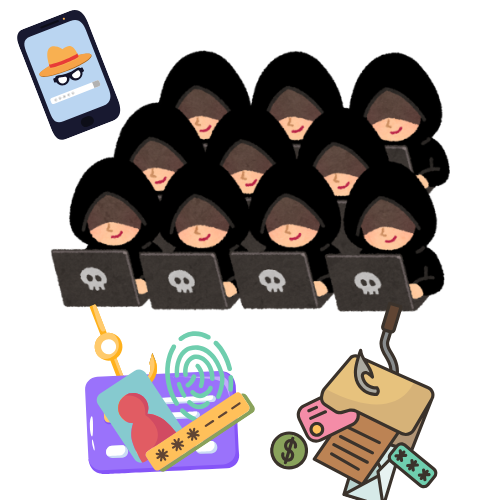In the world of cybercrime, phishing has long been a favorite tactic for tricking people into giving away sensitive information. But as our digital lives have grown more connected, so have the techniques used by attackers. Enter hyper-personal phishing—a new, highly-targeted approach that uses your personal information to fool you into trusting fake messages.
If you’ve ever wondered how an email or message seemed to know so much about you, you might have encountered hyper-personal phishing. In this blog post, we’ll dive into what it is, how it works, and most importantly, how you can protect yourself.
What is Hyper-Personal Phishing?
Hyper-personal phishing is a type of phishing attack where the attacker customizes the message to make it as specific to you as possible. Unlike traditional phishing that often sends the same generic message to thousands of people, hyper-personal phishing is all about making you believe that the message is meant just for you.
Attackers do this by gathering details from your online presence—things like your job title, hobbies, social media activity, recent purchases, or even your travel plans. They then use that information to craft messages that are far more believable and much harder to ignore.
How Does Hyper-Personal Phishing Work?
The secret to hyper-personal phishing lies in the details. Attackers don’t just pull these out of thin air; they do their research. Here’s how they usually gather the information they need:
- Social Media Stalking: If your social media profiles are public, attackers can easily see your posts, photos, job updates, and even your interactions with friends and family. They use this data to learn about your interests, upcoming events, or recent achievements.
- Data Breaches: With data breaches becoming more common, your personal information may already be floating around on the dark web. This could include your email address, phone number, or even your passwords.
- Professional Websites: Sites like LinkedIn and the credit reporting agencies can be a goldmine for attackers looking for details about your job, colleagues, and the projects you’re involved in. They can use this information to pose as a coworker, client, or family member.
- Email Spoofing and Impersonation: Once attackers have enough information, they can create fake emails that look like they’re coming from someone you know, like a friend, family member, or business contact. These emails often look real because they mention specific details only a trusted person would know.
Examples of Hyper-Personal Phishing Scams
To help you understand how convincing these attacks can be, let’s look at a few examples of hyper-personal phishing in action:
- Fake Invitations: Imagine receiving an email that looks like it’s from a close friend, inviting you to a surprise birthday party. The message mentions your friend’s name, the date, and even the venue. There’s a link in the email to RSVP, but when you click on it, it downloads malware onto your computer.
- CEO Fraud: You get an urgent text from your company’s CEO (or so you think), asking you to purchase some gift cards to give to teammates as a surprise thank-you. The CEO just needs you to text back photos of the gift card codes from the back of the cards, which are as good as cash.
- Job Offers: If you’ve been job hunting, you might receive an offer from a company that seems to know all about your skills and experience. They ask you to download a job application form, but it’s actually a malicious file designed to steal your data.
- Nasty Blackmail: An attacker sends you a blackmail letter with your home address and a photo of your home (from Zillow or Google Street View), and a story about how they will tell your friends and family that you were spending time on adult websites if you don’t pay a Bitcoin blackmail.
How to Protect Yourself from Hyper-Personal Phishing
While these attacks are getting more sophisticated, there are still ways you can stay one step ahead. Here are some tips to help you avoid falling victim to hyper-personal phishing:
- Limit What You Share Online: Be mindful of what you post on social media. The more details you share about your life, the easier it is for attackers to craft a believable message. Adjust your privacy settings to limit who can see your information.
- Verify Suspicious Messages: If you receive an email or message that seems unusual, verify it before responding. Contact the sender using a different communication method (like a phone call or via LinkedIn Messaging) to make sure the request is legitimate.
- Enable Multi-Factor Authentication (MFA): Even if attackers manage to steal your password, multi-factor authentication adds an extra layer of security that makes it harder for them to gain access to your accounts.
- Stay Updated on Cybersecurity Practices: Phishing techniques evolve rapidly, so it’s important to stay informed about the latest threats and best practices. Regularly update your software and security tools to protect against new vulnerabilities.
Final Thoughts
Hyper-personal phishing is a dangerous evolution of traditional phishing, using the power of your own personal information against you. As these attacks become more targeted and sophisticated, it’s crucial to stay vigilant and take steps to protect your digital life.
Remember, the more an attacker knows about you, the more believable their messages will be. By being cautious about what you share online and staying alert to suspicious activity, you can reduce the risk of falling victim to this modern phishing tactic.
Stay safe, stay smart, and don’t let hyper-personal phishing catch you off guard!
Share this blog:









